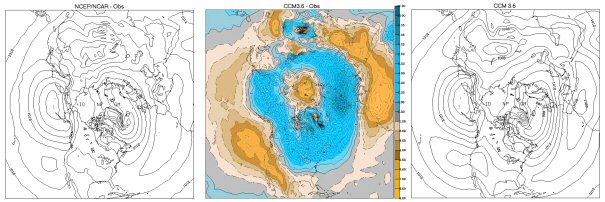ATM 150
Introduction to Computer Methods

Page Last modified: 24 September 2018
ATM150 will be offered fall quarter 2018.
Topics for Fall 2018 offering are under development
but will mainly be drawn from the last offering.
This course may be the only introduction to Fortran
available on the UC Davis campus.
The class meeting times are:
Lectures: 2:10-3:30pm Tuesdays and Thursdays
Lab/discussion: 2:40-5:00pm Tuesdays and 2:40-4:00pm Thursdays.
All class meetings are in room 124 Hoagland
Questions? Contact
me at: grotjahn 'at' ucdavis.edu
General Course Information:
Miscellaneous Programming Aides:
Programming Tips: (First Lab/Disc Period)
- Dr. Grotjahn's
programming advice from
decades of experience. Please read! You might not agree with everything
here, but you may learn things that help you in the long run.
- Types of
programming errors.
Please read! It is useful to be aware of the numerous sources
of errors in the final result. There are some tips on common
mistakes that people make; knowing those may save you some
frustration later....
- A primer on using
formatted writes
for printed (and even plotted) output. This is mainly intended
for those who have little experience producing attractive,
custom output.
- Publication quality graphics are possible using NCL, the
NCAR Command Language. Note that NCL
uses its own scripting language that is partly a mashup of C++ and FORTRAN. It is
powerful and the NCL website has lots of atmospheric science examples,
including code, graphics, and documentation.
- Manipulating netCDF and grib files is faciliated by the unix/linux
commands of NCO the netCDF Operator.
- Some advice for
using NCAR graphics.
This is mainly for those who have never used NCAR graphics before.
- A subset of the
fortran 77 compiler options
are listed here.
- Dr. Grotjahn's
"Laws" of computing
(slightly tongue-in-cheek, there are grains of truth here which
somewhat capsulize information in the "advice" and "errors"
links above.)
Documents related to formal lectures on Fortran:
-
linux commands summary in .pdf format.
-
- A compact, general
fortran 90 lecture slides in .pdf format.
We shall review parts of this lengthy (416 slide) document. Mainly focusing on slides 1-130, and
parts of the 'A Frotran Survey 2' until about slide 229.
-
-
fortran 2003 intro in .pdf format. It includes lots of examples. (There are some grammar errors.)
-
-
fortran 95 intro in .pdf format. Another resource for info on commands. Running a program varies with the OS.
-
Directories for presentations, programs, and assignments:
Web pages related to formal lectures:
*** In preparation, below is outdated, and from 2012****
-
Directory for some transparencies
used in some of the lectures. The format is "lecture#_order#.gif" where
the order# is the likely order the transparency was shown. So, 4_3.gif
was the 3rd transparency of the 4th lecture, etc.
- Lecture group #1: A compact, general
fortran 77 & 90 guide in .pdf format.
We shall review most of the guide. You may skip the
following sections: 1.7.4, 2.5.7, 2.5.8, 2.5.9, 2.5.10.
In case anyone is so foolish as to claim that FORTRAN is dead, or
irrelevant, or inferior to some other language (Pascal ca 1984; C ca 1990;
C++ ca 2000, -- sigh -- ) try to remain polite and patient and aske them to
consider
this link.
That link is contained in a larger
FORTRAN tutorial.
Another source of Fortran 90 information in short html-format
web pages is:
C.-K. Shene's Introduction to FORTRAN 90.
There are other tutorials available on the web. Enjoy!
- Lecture group #2: Grid Points and Taylor Series
to approximate a second derivative using finite differences.
- Lecture group #3: types of numerical approaches for solving
integrals
(under const.)
-
Lecture group #4: types of numerical approaches as deduced from
the canonical forms
of the equation(s).
-
Lecture group #5: Using Taylor series to
construct a 4th order
finite difference scheme for the first derivative.
.pdf file
-
Lecture group #6: Time integration by
flipping indices
.pdf file
- Lecture group #10: types of numerical approaches for solving
multi-dimensional
elliptic equations.
(under const.)
Web page related to computer exercises:
Do you have any questions
 .
.
If so, then we encourage you to contact:
the instructor:
Prof. R. Grotjahn
rm 231 Hoagland Hall, Phone: 752-2246, E-mail: grotjahn'at'ucdavis.edu
(Yes,
that is a "real" satellite image.)
Back to
ATM 150 homepage
Dr. Grotjahn's homepage
Greek and math symbol
jpegs


 .
.